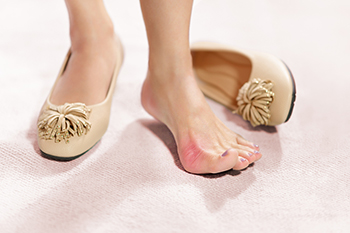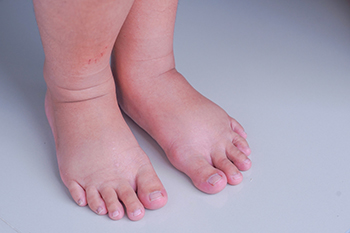Connect With Us
Blog
Items filtered by date: March 2023
Facts About Hammertoes

A hammertoe is a deformity that usually develops on the second or third toe. It is caused by an imbalance between the muscles and tendons in the toe joint. This results in the middle joint rising up to form a peak. In and of itself, a hammertoe is not generally painful. The problem of pain arises when wearing shoes that may cause the raised knuckle of the toe to rub against the top of a shoe. Wearing shoes that do not fit properly along with genetics are the main contributors in the formation of a hammertoe. Shoes with a narrow toe box can force the toes into a flexed position. And the higher the heel, the more the toes are subject to increased pressure. After a while, the toes can no longer extend and they become rigid. This can result in painful corns or calluses. Besides changing your footwear, many patients with hammertoe deformities use orthotics to counteract the toe joint imbalance. In severe cases, surgery may be needed to correct the problem. It is suggested that you consult a podiatrist for an exam and suggested treatment options.
Hammertoes can be a painful condition to live with. For more information, contact one of our podiatrists of Crosstown Podiatry. Our doctors will answer any of your foot- and ankle-related questions.
Hammertoe
Hammertoe is a foot deformity that occurs due to an imbalance in the muscles, tendons, or ligaments that normally hold the toe straight. It can be caused by the type of shoes you wear, your foot structure, trauma, and certain disease processes.
Symptoms
- Painful and/or difficult toe movement
- Swelling
- Joint stiffness
- Calluses/Corns
- Physical deformity
Risk Factors
- Age – The risk of hammertoe increases with age
- Sex – Women are more likely to have hammertoe compared to men
- Toe Length – You are more likely to develop hammertoe if your second toe is longer than your big toe
- Certain Diseases – Arthritis and diabetes may make you more likely to develop hammertoe
Treatment
If you have hammertoe, you should change into a more comfortable shoe that provides enough room for your toes. Exercises such as picking up marbles may strengthen and stretch your toe muscles. Nevertheless, it is important to seek assistance from a podiatrist in order to determine the severity of your hammertoe and see which treatment option will work best for you.
If you have any questions, please feel free to contact our offices located in Wayne, Montclair, and Randolph, NJ . We offer the newest diagnostic and treatment technologies for all your foot care needs.
Causes of Bunions

A hard lump on the side of the toe may be a bunion. It is considered to be a deformity, and large bunions may cause difficulty while wearing shoes. Women can be prone to developing bunions as a result of the high heels that are worn. They generally provide little room for the toes to move freely in, and this may cause the side of the big toe to rub on the shoe. Some patients notice their toes shifting toward each other, as the bunion may cause this misalignment. Corns and calluses may develop on top of the bunion, and putting a protective pad over it may bring relief. Pain may be caused by a bunion, and the toe may become numb or have a burning sensation. If you have developed a bunion, it is suggested that you speak to a podiatrist, who can offer you relief solutions, which may include minor surgery for removal.
If you are suffering from bunions, contact one of our podiatrists of Crosstown Podiatry. Our doctors can provide the care you need to keep you pain-free and on your feet.
What Is a Bunion?
A bunion is formed of swollen tissue or an enlargement of boney growth, usually located at the base joint of the toe that connects to the foot. The swelling occurs due to the bones in the big toe shifting inward, which impacts the other toes of the foot. This causes the area around the base of the big toe to become inflamed and painful.
Why Do Bunions Form?
Genetics – Susceptibility to bunions are often hereditary
Stress on the feet – Poorly fitted and uncomfortable footwear that places stress on feet, such as heels, can worsen existing bunions
How Are Bunions Diagnosed?
Doctors often perform two tests – blood tests and x-rays – when trying to diagnose bunions, especially in the early stages of development. Blood tests help determine if the foot pain is being caused by something else, such as arthritis, while x-rays provide a clear picture of your bone structure to your doctor.
How Are Bunions Treated?
- Refrain from wearing heels or similar shoes that cause discomfort
- Select wider shoes that can provide more comfort and reduce pain
- Anti-inflammatory and pain management drugs
- Orthotics or foot inserts
- Surgery
If you have any questions, please feel free to contact our offices located in Wayne, Montclair, and Randolph, NJ . We offer the newest diagnostic and treatment technologies for all your foot care needs.
Why Are My Feet and Ankles Swollen?

The feet and ankles are likely areas where excess fluid in the body can accumulate. The medical term for this is called edema, and swelling of the feet is a common condition. This swelling can occur for various reasons, including obesity, eating foods that are salty, and taking certain medications. Additionally, many pregnant women suffer from swollen feet and ankles, and this is a normal part of pregnancy. Swollen feet may also happen due to an allergic reaction, such as an insect bite or sting, or from an ankle injury. It is possible that swollen feet can be reduced by limiting sodium intake, gently stretching and exercising, and frequently elevating the feet. It can be beneficial to sit for short periods of time with the feet elevated and to wear shoes that fit correctly. If you have swollen feet or ankles, it is suggested that you speak with a podiatrist who can determine what the reason is and provide treatment solutions.
Swollen feet can be a sign of an underlying condition. If you have any concerns, contact one of our podiatrists of Crosstown Podiatry. Our doctors can provide the care you need to keep you pain-free and on your feet.
Swollen feet are a common ailment among pregnant women and people who stand or sit for extended periods. Aging may increase the possibility of swollen feet and patients who are obese often notice when their feet are swelling too. There may be medical reasons why swollen feet occur:
- Phlebitis - A condition that causes the veins to become inflamed and can also cause leg pain.
- Liver disease - This may lead to low blood levels of albumin which is a protein. This can cause fluid in the blood to pass into the tissues and several areas of the body can become swollen.
- Heart failure - When the heart doesn’t pump properly the blood that is normally pumped back to the heart can pool in the veins of the legs causing swollen feet.
- Kidney disease - One of the main functions of the kidneys is releasing excess fluid in the body. This type of condition can make it difficult for the kidneys to function properly, and as a result the feet may become swollen.
- Deep-vein thrombosis (DVT)- This is a serious condition where blood clots form in the veins of the legs. They can block the return of blood from the legs to the heart which may cause the feet to swell. It is important to be treated by a podiatrist if this condition is present.
Swollen feet can also be caused by bone and tendon conditions, including fractures, arthritis, and tendinitis. Additionally, there may be skin and toenail conditions and an infection may cause the feet to swell. Patients who take medicine to treat high blood pressure may be prone to getting swollen feet.
Many patients elevate their feet to help relieve the swelling and this is generally a temporary remedy. When a podiatrist is consulted the reason behind the swelling can be uncovered and subsequently treated.
If you have any questions please feel free to contact our offices located in Wayne, Montclair, and Randolph, NJ . We offer the newest diagnostic tools and technology to treat your foot and ankle needs.
Causes of Stress Fractures in the Feet

A stress fracture is a tiny, hairline crack in a bone, usually caused by overuse or repetitive actions. This injury is common among runners, dancers, gymnasts, and athletes involved in football, basketball and tennis. Stress fractures frequently develop when a sudden increase in intensity, frequency, and duration of activity occurs. Sometimes the muscles in the foot lack the strength to cope with the higher levels of training or activity. They may not be able to support the bones properly, increasing vulnerability and causing these tiny fractures. Factors that have been found to contribute to foot stress fractures include, gender, age, biomechanics, improper footwear, and bone density. More women than men incur foot stress fractures as the result of hormonal changes and osteoporosis. Flattening arches can cause the bones to absorb more of the force in activity. Stress fractures can be easy to ignore and difficult to detect because when the activity is ceased, the pain and possible swelling often recedes. A podiatrist, after taking a history of the patient’s activity levels, will often order an MRI to be taken, as these injuries can be difficult to see with an X-ray. For more information on stress fractures in the foot, it is suggested that you consult a podiatrist.
Stress fractures occur when there is a tiny crack within a bone. To learn more, contact one of our podiatrists from Crosstown Podiatry. Our doctors can provide the care you need to keep you pain free and on your feet.
How Are They Caused?
Stress fractures are the result of repetitive force being placed on the bone. Since the lower leg and feet often carry most of the body’s weight, stress fractures are likely to occur in these areas. If you rush into a new exercise, you are more likely to develop a stress fracture since you are starting too much, too soon. Pain resulting from stress fractures may go unnoticed at first, however it may start to worsen over time.
Risk Factors
- Gender – They are more commonly found in women compared to men.
- Foot Problems – People with unusual arches in their feet are more likely to develop stress fractures.
- Certain Sports – Dancers, gymnasts, tennis players, runners, and basketball players are more likely to develop stress fractures.
- Lack of Nutrients – A lack of vitamin D and calcium may weaken the bones and make you more prone to stress fractures
- Weak Bones – Osteoporosis can weaken the bones therefore resulting in stress fractures
Stress fractures do not always heal properly, so it is important that you seek help from a podiatrist if you suspect you may have one. Ignoring your stress fracture may cause it to worsen, and you may develop chronic pain as well as additional fractures.
If you have any questions, please feel free to contact our offices located in Wayne, Montclair, and Randolph, NJ . We offer the newest diagnostic and treatment technologies for all your foot care needs.

